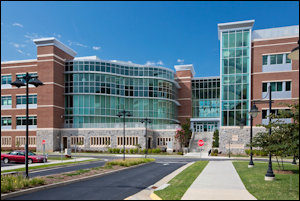 The Virginia Tech Carilion health sciences campus is emerging as the new economic growth engine for Roanoke. The impact of the campus on the state’s economy will grow from $214 million today to $465.2 million within eight years, according to a study issued by the University of Virginia’s Weldon Cooper Center for Public Service.
The Virginia Tech Carilion health sciences campus is emerging as the new economic growth engine for Roanoke. The impact of the campus on the state’s economy will grow from $214 million today to $465.2 million within eight years, according to a study issued by the University of Virginia’s Weldon Cooper Center for Public Service.
The addition of a second building at the research institute will create 828 new jobs and generate $150 million in additional spending by 2026, reports the Roanoke Times. The figures measure only direct impact, not the effect of undergraduate students studying there or spin-off development in the surrounding area.
“I think that as a region we need to think big because this is an opportunity that comes our way once a century,” said Heywood Fralin, chairman of the VTC Academic Health Center Steering Committee. The last time anything this big happened in Roanoke was when the Norfolk & Western Railway moved its headquarters in 1882 to the area then known as Big Lick.
The Roanoke Times provides the history of the initiative:
Tech and Carilion formed a partnership a decade ago to build a medical school and research institute on the Riverside campus. The research institute is at capacity, and a new building is underway that will double its size and expand its reach in advancing medical discoveries through trials and to market. Tech intends to offer more undergraduate programs in Roanoke centered around its school of neuroscience, and the Virginia-Maryland College of Veterinary Medicine will move its cancer treatment center to Roanoke. Four companies have been spun off from research since 2010. At that pace, the economist expects 10 more companies will form by 2025.
Here’s the catch:
“Clearly, the more financial support we can give to this effort the better it will be,” Fralin said. “There is an enormous list of things that are needed. To date, the commonwealth of Virginia has funded the buildings. I don’t think it’s reasonable to assume that every building going forward will be built by the commonwealth.”
Bacon’s bottom line: Before I launch into a contrarian mode of thought, let me make it crystal clear that Roanoke desperately needs a new pillar to its economy. Its old industrial-era economy has been hollowed out. The region needs to look to a knowledge-economy model of development rather than vainly try to rehabilitate the old manufacturing model. The research-center initiative brings together two of western Virginia’s key players, Virginia Tech and the Carilion health system, who have the financial clout and know-how to make things happen.
But I do find myself compelled to ask, who’s paying for all this?
Clearly, the Commonwealth of Virginia will be paying for the buildings — through state-backed bond issues, I presume. That’s fine, the state pays for higher-ed buildings across the state, and it’s only fair that Roanoke get its piece of the action.
But who’s paying for all the faculty, researchers, graduate students, and support staff? Hopefully, some of the money will come from federal and private-sector research contracts. Great! But how much? How much is coming from Virginia Tech and how much from Carilion? Digging deeper, where does Virginia Tech get its money, and where does Carilion get its money? To what extent, if any, are these new programs being subsidized by undergraduate tuition payments? To what extent, if any, are they being underwritten by higher-than-needed profits generated by the “nonprofit” Carilion health system?
Another way of asking the question: To what extent are Virginia Tech students paying higher tuition and Carilion patients paying higher medical bills in order to build the campus? To what extent is wealth being extracted from taxpayers, students, patients, and even local philanthropists to fund this research complex? Perhaps most critically of all, to what extent will the health science campus require ongoing subsidies forever?
The buildings, contracts and jobs being created are highly visible, and their economic impact is easy to measure. The funding sources are highly dispersed and largely invisible. Their economic impact is impossible to measure. Does the health science campus represent the optimal investment of society’s resources? Who knows? Nobody is even asking the question.


